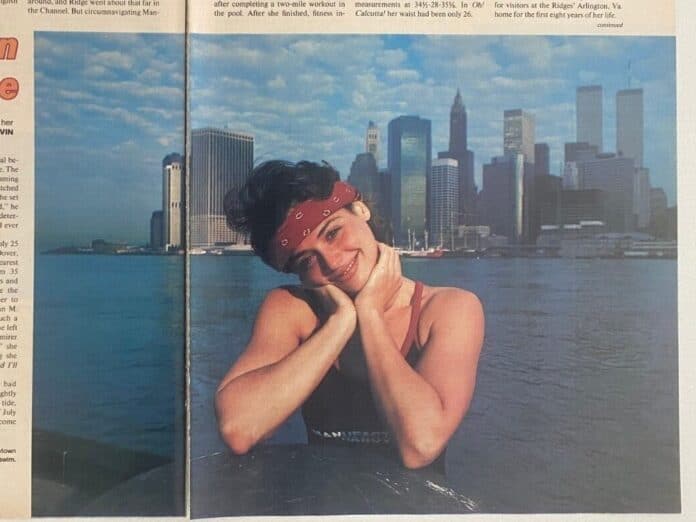
On Aug. 6, 1926, 19-year-old Gertrude Caroline Ederle was the first recorded woman to swim across the English Channel. She was an American competition swimmer, an Olympic champion and a world record-holder in five events.
On Sept. 10, 1982, 56 years later, 25-year-old Julie Ridge swam the channel. She was the 242nd person to swim more than 21 miles between England and France, taking 17 hours and 55 minutes to do so. The average solo crossing time is 13 hours, 33 minutes and 54 seconds.
Ridge’s story has become a one-woman play that will be performed at the Mary D. Fisher Theatre at 4 p.m. on Saturday and Sunday, May 27 and 28. “Bipolar & The English Channel” follows Ridge’s story of dealing with mental illness and physically pushing herself to the extreme.
Sedona International Film Festival Executive Director Patrick Schweiss said that the minute he met Ridge he knew he had to bring her to Sedona.
“It is so important to bring plays like this to our audience. It can help people understand bipolar disorder and learn how to navigate the challenges, whether you are the one dealing with the disorder or a family member,” Schweiss said. “Powerful plays like this help people realize they are not alone, and Julie’s inspiring story has the power to help so many people.”
Across the Channel
Ridge grew up in Arlington, Va. Since age 12, her dream was to perform on Broadway.
“My mother wanted me to get a degree in English and I said I’m not going to college if I have to do that,” Ridge remembered. “Dad was paying for school, and he said follow your dream, it’s fine. I’ll send you where you want to go. I got into Boston University, which was one of the best schools for acting at the time.”
During her sophomore year at Boston University, her swimming coach saw how she swam and told her acting would be a more promising choice for her. After graduation in 1978, Ridge landed a role in “Oh! Calcutta!” in Chicago, and when that show closed, she moved to New York to appear with the Broadway company.
By night she sang in “Oh! Calcutta!” and by day she swam a casual mile at the Manhattan Plaza Health Club 25-yard pool. She notes that she was a poor to moderately-skilled swimmer and swam to stay in shape and maintain her peace of mind. During one of those swims, the idea of swimming the English Channel popped into her head.
When a fellow swimmer broke his wrist during a movie shoot, she adopted his mileage as “a sort of tribute.” Two miles was double her usual routine. She accomplished that distance with little effort and began to wonder how far she could go. Testing her limits, Ridge said that she swam five miles, which took 360 laps and three hours. She climbed out of the pool feeling “a little tired but otherwise sensational.”
“I transcended some physical threshold and entered a mental state that friends who’d done hallucinogens described. But this was legal, and I could get it for free,” she said.
On Jan. 1, 1982, Ridge made a New Year’s resolution to swim the English Channel on Sept. 9, her 25th birthday, nine months away. Her father told her that if she was going to do this crazy thing, he was going to be on the boat coaching her.
To prepare for the English Channel, Ridge read every book she could about endurance swimming and the channel. She spoke to great swimmers and contacted James E. “Doc” Counsilman, Ph.D., an Olympic and Hall of Fame swimming coach whose book, “The Science of Swimming,” is considered the Bible of competitive swimming
In 1979, at age 58, Counsilman was the oldest person to swim the channel. He mapped out his 18-month training program for her; however, Ridge had only nine months.
Ridge recounted training with Buck Dawson, the first executive director of the International Swimming Hall of Fame in Fort Lauderdale, Fla., who ran the competitive swimming camp — Camp Ak-o-Mak for girls — in Ontario, Canada. Ridge said that Dawson didn’t think she had a chance of making the swim but did invite her to his endurance swimming camp to train.
Ridge noted that “long-distance swimming had become my meditation and unbeknownst to me — the core of my sanity.” She described her experience with other swimmers as “being alone with our thoughts, our demons, our dreams and our futures.”
At 5:10 a.m. on Sept. 10, 1982, just ten minutes after her 25th birthday, Ridge began her swim in the English Channel. After 11 hours of fighting the changing currents, she was tired and sore and faced with a difficult swim to the French Coast. She was off course and had miles left to cover, but her father coached her to the finish.
At 11:05 p.m., Ridge became the 242nd person to swim from England to France. From that moment on, her life changed.
To the Extreme
When Ridge returned to New York City, she didn’t have a job, apartment, boyfriend or money and was suffering from extreme post-event depression. She needed another goal that would enable her to push her limits. At a friend’s suggestion, Ridge decided to swim around the island of Manhattan twice, since those before her had only swum its perimeter once.
In 1983, Ridge became the first person to swim twice consecutively around Manhattan, covering approximately 57 miles in 21 hours, two minutes and 41 seconds. That feat garnered the attention of Sports Illustrated, which was followed by an invitation to appear on the David Letterman Show.
“That was the coolest thing I’ve ever done in my life,” Ridge said about the appearance. Letterman questioned Ridge about swimming around Manhattan, noting the dangers of barge traffic on the Hudson River, the cleanliness of the river, the presence of any dead bodies floating in the water and the rough currents, commenting, “This is no day at the beach.”
Ridge, amused at his questions, responded that although swimming was difficult in places, the sightseeing was beautiful from her perspective and she did not see any floating dead bodies.
“This swim was almost easy because I didn’t have to worry about thinking about things,” Ridge said. “There was so much to look at in terms of the island in spotting points and knowing when I was passing places. I could tell how much progress I was making.”
Ridge appeared on “Good Morning America” in addition to media stories that followed. “Most of the decisions I’ve made — like the decision to swim the English Channel, the decision to swim twice around Manhattan, the decision to take an apartment, the important decisions in my life — have all been made in the water. It’s like something becomes clear, and it clicks,” she said.
Ridge continued doing triathlons and also biked across America with her father, Frank. It wasn’t until 1991 that her life came crashing down.
Bipolar Diagnosis
“Life exploded when my husband declared he wanted to divorce in early 1991, and that triggered my bipolar disorder,” Ridge said.
She recalled having a complete manic breakdown. In her one-woman act, Ridge observes, “I climbed on the railing of my 13th-story balcony, wanting to feel the sensation of flying … In a moment of clarity, it dawned on me that without help, I’d go splat, so I got off the balcony.”
Ridge said that the episodes got worse, and she eventually found herself handcuffed in the back of a police car and sent to a hospital, where she was diagnosed with bipolar disorder.
In 1994, Ridge graduated from Columbia University, where she studied mental illness. She decided to dedicate her life to helping others. Now a licensed clinical social worker with over 20 years of experience, she serves children, adolescents and families.
“It’s about not giving up. Believing in yourself. And the show [“Bipolar and The English Channel”] is the intersection of bipolarity accomplishing something in the water,” Ridge said. “So that message is the same — whether it’s swimming across the English Channel or living a life with bipolar disorder, it is about not giving up and it is about finding support.”
The World is Her Stage
Ridge brought acting back into her life by writing and creating “Bipolar and the English Channel,” the story of her life and her experience with mental illness. In the hope of helping others, she began performing off-Broadway, and in 2013, she established the Frank Ridge Memorial Foundation in her father’s honor. She
has since written a book, “Take it to the Limit,” has been inducted into the International Marathon Swimming Hall of Fame and takes each day at a time, trying to spread awareness about bipolar disorder.
“There are times in my show I am unable to get through without tearing up, and it’s fresh every single time,” Ridge said. “I want to let others know that there is hope and there is a future and it can get better. Just put in the work and find the right support.”


















